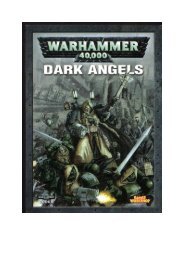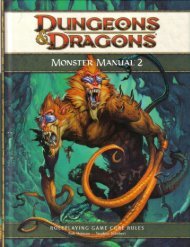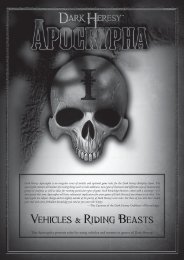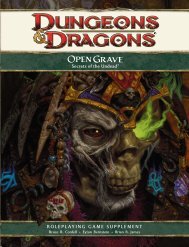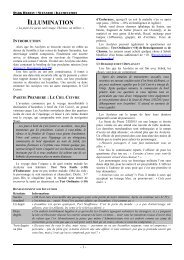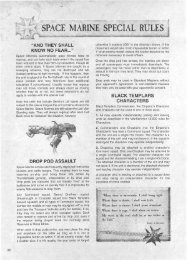You also want an ePaper? Increase the reach of your titles
YUMPU automatically turns print PDFs into web optimized ePapers that Google loves.
BROWN DRAGONS BY SIZEOverall Body Neck Tail Body Standing Maximum MinimumSize Length Length Length Length Width Height Wingspan Wingspan WeightMedium 17 ft. 5 ft. 6 ft. 5 ft. 3 ft. 5 ft. 17 ft. 6 ft. 350 lb.Large 30 ft. 10 ft. 11 ft. 10 ft. 5 ft. 9 ft. 29 ft. 11 ft. 3,000 lb.Huge 50 ft. 17 ft. 18 ft. 20 ft. 8 ft. 15 ft. 49 ft. 29 ft. 25,000 lb.Gargantuan 80 ft. 24 ft. 28 ft. 33 ft. 10 ft. 20 ft. 65 ft. 32 ft. 180,000 lb.When a brown dragon dies of old age in its desertlair, the dry air might preserve and mummify it,making it one more relic of lost time buried by thedesert sands. When a deceased brown dragon experiencesenvironmental diffusion, the result is an areaof quicksand. Any creature that enters the quicksandmust succeed on an Acrobatics or Athletics check(DC equal to the deceased dragon’s level) in order toescape.Physical CharacteristicsThe various hues of a brown dragon’s scales allow itto blend in with the sands of its terrain. Like green<strong>dragons</strong>, brown <strong>dragons</strong> might allow their scales tobecome scarred, tarnished, and rough to make themappear more like earth or like rocks in the sand.The greatest difference between a brown dragonand other <strong>chromatic</strong>s is the strange structure of itswings. Instead of normal dragon wings, a double crestof spines stretches from the head to the tip of the tail,each crest connected to the other by a membranousfrill. The frill allows a dragon to swim through sandand earth, and, if need be, fly through the air.Gray DragonsIn some ways, gray <strong>dragons</strong> are the most enigmaticof all <strong>chromatic</strong>s. Lacking in distinctive hue, theyare hunters on stony borderlands, forever soaring inthe sky’s embrace. Also called fang <strong>dragons</strong> (for theirferocity), stone <strong>dragons</strong> (for their ability to petrify victims),and spike <strong>dragons</strong> (for their detachable spikes),these beasts share the worst qualities of other <strong>chromatic</strong><strong>dragons</strong>.Grays delight in the hunt at least as much as itsfruits. Their desperate, animal love of stalking preymight be their defining characteristic.Few gray <strong>dragons</strong> can muster sufficient self-disciplineto reach the heights of power and reputationother <strong>chromatic</strong>s enjoy. Grays spend their time farfrom their lairs, glorying in the savage thrill of thehunt and basking in their quarry’s fear.Gray <strong>dragons</strong> are corruptible beasts, willing tocompromise any stated principle when better alternativescome along. Grays particularly delight inturning social encounters into excuses to begin elaboratechases. Even when receiving gifts of gold or othervaluables in exchange for assistance, a fang dragonmight break off negotiations to present the terms of agame, something like this: “You have until sunrise toflee as far as you can. At that time, I begin my huntfor you. If I find you, you lose.”On the other hand, gray <strong>dragons</strong>’ unpredictabilityensures that they do not always act this way. Perhapsthey know that creatures that fall into routine makeeasier prey themselves. A shrewd diplomat can takeadvantage of this side of a gray dragon’s nature bypromising the dragon a better, future opportunity fora hunt, thus hedging a negotiation away from failure.The occasional gray dragon finds itself the focusof savage humanoid tribal worship. Particularlyprimitive tribes might kowtow to gray <strong>dragons</strong> inhopes that the <strong>dragons</strong>’ aptitude for stalking prey willtransfer to them. More sophisticated tribes select sacrificialvictims either from among their own numberor, more often, from among members of enemytribes or visitors from distant lands. Upon obtaininga victim, members of such a tribe contact thegray dragon, possibly with smoke signals. Then theyrelease the poor soul with little or no equipment—perhaps a warning and a flint knife—to flee acrossbarren scrubland or badlands.Gray <strong>dragons</strong> might act as field scouts, spies, andhounds for sophisticated locals who have powerfulinterests. Payment for such a service is the serviceitself, which the dragon sees not as a service at all,but as an enjoyable pastime. Since a gray invariablyeats what it catches, employers never entrust it withthe delivery of live bounty—though the dragon mightdeliver a skull or another gnawed bone fragmentfrom its quarry.When hungry enough, a gray might stoop to feedingon domestic cattle, sheep, or other herd beasts,but it does so rarely; dim herd animals offer littleGRAY DRAGONS BY SIZEOverall Body Neck Tail Body Standing Maximum MinimumSize Length Length Length Length Width Height Wingspan Wingspan WeightMedium 15 ft. 5 ft. 5 ft. 5 ft. 2½ ft. 3½ ft. 25 ft. 12 ft. 300 lb.Large 30 ft. 9 ft. 8 ft. 13 ft. 4½ ft. 6½ ft. 36 ft. 18 ft. 2,400 lb.Huge 53 ft. 15 ft. 15 ft. 23 ft. 7 ft. 11 ft. 60 ft. 30 ft. 19,500 lb.Gargantuan 83 ft. 23 ft. 23 ft. 37 ft. 9 ft. 15½ ft. 80 ft. 40 ft. 159,000 lb.CHROMATIC DRAGONS IN DETAILCHAPTER 1 | Dragon Lore35



